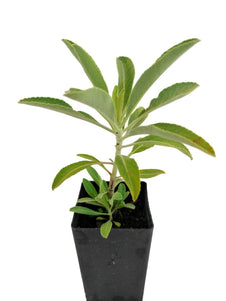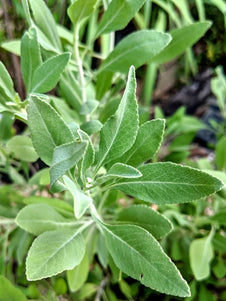











Salvia apiana 'White Sage'
Salvia apiana 'White Sage'
- In stock, ready to ship
- Inventory on the way

Usually available: All year
Life cycle: Perennial
Height: 1.3 - 1.5m
Position: Full sun
Soil preference: Well drained
This is how we pack and send your Herb Plants to all states except TAS & WA
You will receive
- 1 White Sage Herb Plant in a 50 X 75mm tube - General growing instructions
All of our Herb Plants are grown organically with certified organic potting mixes and fertilizers
Botanical Name: Salvia apiana
White sage is a large, herbaceous perennial, sometimes called ‘bee sage’’ or ‘sacred sage.’ It may grow from 1.3 to 1.5 meters in ideal conditions and is one of the larger salvias. The slightly purple flower stalks extend up almost the same height again and bear small white to lavender flowers. The long, grey or silvery white leaves are highly aromatic when crushed and lend white sage its name. The bottom of the stem is quite woody, with a fleshy top and leaves grow in florets at the top.
The plant is also called ‘apiana’ because of the great bee attractant qualities. Wasps, hawk-moths and hummingbirds are also attracted to the plant in its native Californian environment. It is found in mainly in the coastal scrub areas and rugged hills of Southern California and the Western edge of the Mojave and Sonoran deserts.
White sage is highly valued by Native Americans as a ceremonial and ritualistic plant. It is deemed to have great spiritual and emotional cleansing properties and is now used by many people for this purpose. Sage emits negative ions, much like running water and can impart uplifting feelings. Sage, in the form of ‘smudge sticks’ are used in cleansing and purification ceremonies, even in the 21st century. Try out the Australian grown white sage smudge stick to experience the calming effects yourself.
White sage is revered for its mystical qualities and naturally growing white sage is becoming increasingly rare, due to its commercial uses.
Growing Conditions
White Sage can be tricky to grow. It needs REALLY good drainage, FULL sun, good airflow, and hates it leaves being wet. Also, pruning to keep the centre of the plant open for airflow will help.
White sage is native to only a small part of southern California and northwestern Mexico. It prefers conditions that replicate this often coastal and dry, sloping environment on the edge of the desert. Deep watering is only required once every two weeks, with sandy, well-drained soil in a sunny position. It will tolerate cool conditions, but shade, humidity and over watering will result in poor performance. In frost zones, white sage can be grown in pots and kept indoors. In these areas, it is best to treat white sage as an annual.
White sage can be grown from seed, but there are conflicting reports about how the degree of success. Some account say it is quite easy and others say the germination rate of white sage is very low, with a success rate of 15%. If taking this approach, make sure to sow a much greater amount than you need. It may be helpful to sow in seed trays, using a cactus potting mix. Water well and then keep very lightly watered as represented in dry conditions. Wait until seedlings appear and then plant out approximately 60 cm apart. White sage will easily hybridise with other salvias.
To harvest white sage, cut the stems being careful to note which part of the stem is fleshy and which is woody. If you cut into the fleshy top, the plant will produce 2 stems next year. If you cut the woody base, then no new growth or leaves will appear. Hang the stems upside down to dry and then bunch together to form ‘smudge sticks’. The dried leaves can be kept for teas and you may use them in food if you wish. Collect the seeds to plant the following year, by saving the brown nut like fruits before the seeds are released.
Culinary Uses
Native American uses for white sage included using leaves as a source of flavouring in meal preparation. They also ground up the seeds and mixed with flour to create porridge and biscuits. The seeds, roots and leaves are all edible.
Medicinal Uses
White sage is rich in cineole, a chemical with antiseptic properties, also found in rosemary and eucalyptus. The active constituents also have a reputation as anti-bacterial, anti-inflammatory, anti-spasmodic and pain reducing qualities. Cineole, ingested in a tea or inhaled from burning leaves helps to break up mucous, relieve congestion and stimulate clear breathing.
The traditional medicinal uses of white sage by Native Americans included as a cold remedy, for fevers and painful or heavy menstruation and for healing and strength after childbirth. It was also reputed to rid the body of foul odours when the leaves were crushed and rubbed all over the body. Warm sage tea is said to be good for sore throats and cold tea for stomach aches. The seeds were also used to remove foreign objects from the eyes, much like Clary sage in Europe.
Other Uses
White sage, as ‘smudge sticks,’ is used for ritually and for aura cleansing of any space, including house or car and even people.
Native Americans used white sage infusions as a rinse for shiny hair and to reduce grey hair. The grey foliage is also very useful in decorative wreaths and potpourri.
All information provided on this website is for informational purposes only. Please seek professional advice before commencing any treatment.





